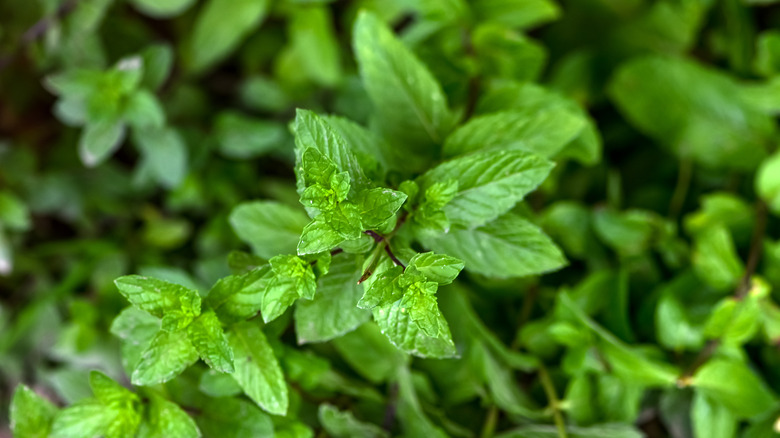Why Your Body Perceives Mint As Cold, According To Science
Mint is ubiquitous with frosty fresh flavors and feelings. Whether it's refreshing iced tea, culinary delights, mints and gum for fresh breath, infused cream for tired feet, après swim shampoo, or a cooling accompaniment to spicy ethnic cuisine — mint has one job and that is to cool us off.
According to The Spruce, there are at least 11 types of mint you can grow in your garden, and each offers a different flavor and tactical feeling. Peppermint, spearmint, chocolate mint, watermint, apple mint, the list goes on. Martha Stewart says spearmint is the most common mint used in cuisine and beverages like the iconic mint julep because of its soft yet pure mint flavor. Peppermint, a cross between spearmint and watermint, has a distinctively strong and sharp minty quality, making it perfect for desserts, confections, and cosmetics. Chocolate mint, meanwhile, smells like an Andes Crème de Menthe after-dinner chocolate mint, but tastes more like orange peel.
Cuban mojito mint and Mexican margarita mint have been cultivated to enhance flavors that are perfect for their respective drink recipes, while American wild mint and Corsican mint are rustic in texture and flavor. The other mints out there, like pineapple mint, Egyptian mint, and corn mint, are not easy to find unless you grow them yourself. Peppermint and spearmint are abundantly grown, of course, easily accessible, and delicious accents to your drinks and dishes.
As for why the body perceives mint as cold, science says it has to do with a specific chemical compound.
What science says about mint's cooling effect
What is it about these magical herbs that are so refreshing and deliciously cooling? According to science, mint plants contain a chemical compound called menthol that feels and tastes cool. WebMD reveals that spearmint also contains a compound called carvone, giving it a milder flavor, whereas peppermint contains higher levels of menthol and menthone, adding to its invigorating coolness.
Pediaa tells us that menthol is a crystalline monoterpene compound that occurs in nature, and is synthetically manufactured. Both mint and menthol are used in cooking, cosmetics, and medicine, and both also have antibacterial properties. Products developed to remedy aches and pains use menthol as an ingredient for its analgesic and anesthetic qualities. Mint tea, meanwhile, is a home remedy for digestive issues, and has long been used for mild colds, menstrual cramps, muscle soreness, and tension headaches; it's also a delicious treat.
According to Live Science, menthol, the ingredient in mint responsible for its cool feeling, is actually just playing a trick on the brain by engaging with specific neuron receptors that contain a protein called TRPM8. Your mouth or skin thinks it's cold but it isn't. In other words, the cool feeling you get from mint and menthol is all in your head!

